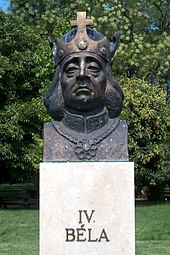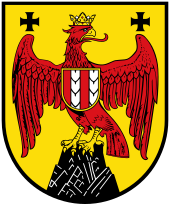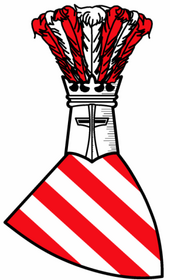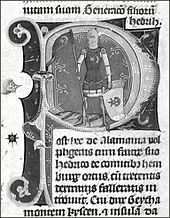Lords of Güns
The Lords of Güns (Hungarian: Kőszegi család, Croatian and Bosnian: Gisingovci) were a noble family in Hungary in the High Middle Ages . The Günser (von Heder) emerged as a branch of the Hungarian Héder family in the 12th century . Among the family members were Palatine and Gespane , Bane and Voivodes . You were one of the seven influential oligarch families in Hungary at the time of the "oligarchic rule " during the last Árpád kings . Their power was based largely on the possession of castles in southwest Hungary and Croatia (rule Međimurje ) and Slavonia . At the beginning of the 14th century, the Güns lords were ousted under King Karl I. Robert or were absorbed by the Lower Austrian nobility and thus lost their importance.
Origin and name
Wolfer , brother of Heidrich, is considered to be the ancestor of the Lords of Güns . The brothers probably came to Hungary in the 12th century. According to Alfred Ratz, the family can be expected to appear as early as the 11th century. In the German-language historiography, the term "Güssinger Grafen" has become established. The Güssing people were neither counts nor did they have their headquarters in Güssing , they had it in Kőszeg . In Hungarian literature the gender is (more correctly) called "Kőszegi" (= Günser). In the documents the family is referred to as “generacio Heyderici” (1265) or “genus Heydrich” (1279).
history
Ascent
Wolfer's son, Heinz I. , played no significant role in public life. The grandson of Wolfers, Heinrich I , was from the Hungarian King Béla III. the wooden castle and the monastery in Güssing withdrawn in order to build a royal castle in its place. Heinrich I (also called Aenz or Henz) is also the namesake of the Burgenland dialect Hianzisch . According to one of several controversial theories, the name Hianzische goes back to Henry I. Heinrich I did not hold any public office either.
Heinrich II. (1228–1274), also known as Heinrich the Great , son of Heinrich I, succeeded in making the Güssing family important. He became chief clan of several Hungarian counties and for a short time also curial judge of the Kingdom of Hungary. Heinrich II. Had been the administrator of eleven royal castles in Eisenburg County from 1244 and was allied with the Bohemian King Ottokar II . As Palatine (around 1260) and Banus of Slavonia between 1254 and 1274, he temporarily directed the fortunes of Hungary. As a Banus he had the right to mint his own coins. He was the lord of the royal castles Bernstein and St. Veit ( Velem ) and had Schlaining Castle built. Together with his son Iwein, he founded the castle and town of Güns ( Kőszeg ). Güns was granted town charter by him and later became the main residence of the Lords of Güns.
Swing policy
On the side of King Béla IV against his son

During the armed hostilities (started in 1262) between King Béla IV and his son Stephan V , the Günser under Henry II held the king. In the last battle between the king and his son at Isaszeg , his son Stephan was victorious. In this battle, Heinrich II and his son John I (Ivan) were taken prisoner by Peter von Csák from the entourage of Stephen. This resulted in the family enmity of the Günser towards the Csák family . After the death of Béla (1270), Henry II fled to Prague. He had Anna, the daughter of Bélas, numerous supporters of the Günser and the Hungarian coronation insignia with him. Heinrich married a Bohemian noblewoman. He handed over his goods and fortresses Bernstein , Gaas , Güns, Schlaining and St. Vitus to the Bohemian King Ottokar II. Přemysl . In 1271 Ottokar II Přemysl and Stephan V. concluded a peace treaty. Among other things, this resulted in the mutual dropping of the Günser and the return of the goods Bernstein, Gaas, Güns, Schlaining and St. Veit to the Hungarian king, which he was ultimately only able to recapture by force of arms.
After the death of Stephen V (1272) the situation changed. The Günser returned to Hungary and their previous positions. When the Bohemian King Ottokar II Přemysl invaded Hungary together with some Hungarian partisans in the spring of 1273, the Günser were again on the side of the (new) Hungarian King Ladislaus IV. Under John I, the Bohemian army could be defeated at Pereszteg and Lócs . The siege of Güssing by the Bohemians had to be broken off without result. When Ottokar learned of the election of Rudolf I of Habsburg as Roman-German king , he finally broke off the campaign in Hungary.
John I attacked the Archbishop of Gran and the Bishop of Agram , which earned him excommunication several times .
For and against King Ladislaus IV.

After Ladislaus IV ascended the throne , Heinrich II briefly confessed to the new king and fought at his side in the war against King Ottokar in 1273. An intended property revision of Ladislaus' soon led to a rebellion of the Günser against the king. The rebellion was put down in the Battle of Polgárdi in 1274. Heinrich found death in this battle. After these armed conflicts between Heinrich II. And the Hungarian king, the Lords of Güns were reinstated in high Hungarian offices and the property could be increased again.
Heinrich II was married in his second marriage to a daughter of the Bohemian nobleman von Leuchtenberg. The mother of his sons is unknown. The sons were Péter ( Bishop of Veszprém ), John I (also called Iwein , Iwan , Ivan the Red Knight or Yban ), Nicholas I and Heinrich III (Banus of Slavonia). In 1279 there was a separation of property between Johann I and his brother Nikolaus I. The sons united in order to recapture their old fortress Güssing from Güns , which was also successful. Johann I recaptured Bernstein Castle in 1277, which subsequently withstood all kinds of attacks until his death in 1306. In 1286 the Hungarian Diet ordered John I to surrender goods that had been taken illegally. Thereupon there was another fight between the Günser and the royal family. King Ladislaus IV relieved the Güns gentlemen from all their offices, he besieged Bernstein in vain in January and February 1284 and suffered a defeat.
Güssing feud
As a result of the failed attacks by King Ladislaus on Bernstein, the Günser family strengthened again and incursions into Austria, Styria and Hungary followed. Johann I von Güns pursued an aggressive policy of expansion, which culminated in the Güssing feud . In 1289, together with his allies, the Counts of Mattersdorf-Forchtenstein , he was defeated by the Austrian Duke Albrecht I , who had intervened at the request of the Hungarian King Ladislaus IV, and lost his lands, which were now occupied by the Habsburgs. The Güssing feud ended with the peace treaty of Hainburg on August 26, 1291, followed by peace with the Kingdom of Hungary on August 28 in Pressburg. The peace agreement also included the return of the conquered rulers to the Günser.
In the years after the Güssing feud, the County of Güns managed to rise to one of the most important noble clans in the era of the "Hungarian Oligarchy" through a rigorous power policy under Johann I. After the death of Johans I in 1307, his son Johann II. Farkas (Wolf) retired to Bernstein Castle and became the ancestor of the "Bernstein Line". Nikolaus II. Kakas (Hahn) , son of Nikolaus I and married to Elisabeth von Pottendorf , sat on Güssing. His son Heinrich IV was the founder of the "Rechnitz line", his brother Johann IV. Ancestor of the "Lockenhauser" line.
End of power influence
1301 died with King Andrew III. the last Árpáde. Hungary, which had been a unitary until then, then split up into several “small kingdoms” under the rule of seven oligarchs. One of these oligarch families was the von Güns. At that time, members of the family owned 14 castles. In the first decade of the 14th century only the oligarch Matthäus Csák had more castles in Hungary. In historical research it was sometimes assumed that they were striving for a sovereign principality of their own. Heide Dienst rejects this thesis because the family not only had too little time for this undertaking, but also because, from their point of view, the establishment of their own principality was structurally impossible.
King Charles I Robert finally tried to consolidate the Kingdom of Hungary and limit the power of the oligarchs. Nikolaus II. Kakas and Johann II. Farkas soon felt disadvantaged by this and, together with other families of oligarchs, rebelled against the king. Charles I finally turned against the Günser. In 1321 he appointed Laurencius Osl , who supported the king in the battles against the Günser, as the successor of Andreas von Güns to the Count of Zala and gave him the town of Kanizsa from the Günser property. Finally, King Karl sent an army under Alexander Köcski, which in 1327 finally captured Güns. In 1328 Güssing also had to be handed over to the king.
In 1327, King Karl ordered the restoration of border guards in the Wart, an area that had previously belonged to the Günsern. The royal border guards of the Hungarian Gyepű system had to guard the area between Güssing and Bernstein. The main castles of the Günser were now owned by the King of Hungary. The Lords of Güns lost their influence, were forced into the interior of Hungary or were absorbed by the Lower Austrian nobility.
Johann II. Farkas traveled to Austria in 1336, took the oath of allegiance to Duke Albrecht II and then lost all possessions. He took the name Pernstein. The Pernstein line was extinguished in 1382. Nikolaus II. Kakas died in 1332, whereby Lockenhaus Castle passed into royal possession. His widow and sons also swore the oath of allegiance to the Austrian duke, but returned after a short time and were enfeoffed with Rechnitz . The descendants stayed here under the name "Rohonczy" until 1414. According to a family tree, members of the family are known until 1527.
Significant family members



In the course of their history, the Günser were Bane of Slavonia, Palatine and holders of court offices such as court judges , chief stable masters and chief treasurers and they had their own court judges, court attendants and notaries at their courts . They had fought against the dukes of Austria, the kings of Bohemia and Naples, and also against their own kings. The oligarchic system had allowed them to pursue their own foreign policy. They held high church offices and they even took a stand against the papacy. Significant members of the family included:
- Heinrich II. (Heinrich the Great) 1228–1274, district judge, Palatine , Banus
- Peter I, Bishop of Wesprim 1135–1138
- Johann I (Ivan) 1235–1308, royal treasurer, Palatine, Banus
- Nicholas I 1266–1297, Palatine, Banus
- Virunth 1216–1254, Canon and Archdeacon of Raab
- Nicholas IV. 1308–1336, Bishop of Raab
- Andreas I. 1327–1352, provost of Eisenburg
- Johann II. (Farkas, German wolf), ancestor of the " Bernsteiner Line"
- Nikolaus II. (Kakas, German rooster)
- Nicholas III 1307–1314, royal treasurer
- Andreas II. 1312-1324, chief counselor
- Andrew III, Vicegespan
- Johann IV. 1406, voivode , ancestor of the " Lockenhauser Line"
- Raphael 1433–1455, Bishop of Bosnia
Manorial and buildings
The power of the Günser was based primarily on the possession of castles . Until 1339 a total of 40 castle lords in the counties of Eisenburg , Ödenburg , Wieselburg , Raab , Veszprém , Zala , Somogy , Tolna , Baranya as well as in Slavonia, Čakovec and Varaždin are documented in their possession. Some of the castles had been bought and some were conquered by force. The lords of Güns owned the following lordships and castles:
- Bernstein Castle (until 1340)
- Güssing Castle (until 1327)
- Kanizsa Castle (until 1321)
- Kőszeg / Güns (with two castles until 1327)
- Schwarzenbach Castle (owned by Count Iwan von Bernstein until 1389)
- Lockenhaus Castle (until 1340)
- Neckenmarkt Castle (until 1289, destroyed in the Güssing feud in 1289)
- Roy Castle near Donnerskirchen
- Schlaining Castle
- Veliki Tabor Castle
The Benedictine abbey in Güssing can be accepted as the first family grave. Henz, Wolfer's son, gave King Béla III. finally the patronage of Kapornak Abbey as a replacement for the monastery in Güssing. Kapornak served from then on as the burial place of the Lords of Güns. The building of the churches of Kőszegszerdahely and Kőszegdoroszló can certainly be attributed to the Günsern . Presumably, however, a number of other church buildings can be traced back to the family (e.g. church buildings in Rechnitz, Goberling and Rattersdorf .)
The Lords of Güns carried out extensive clearing in their dominion to reclaim land. According to Ratz, it is very likely that the Günser mined in this area and extracted iron, copper, antimony , lignite and salt, among other things .
Burgenland coat of arms

The coat of arms of Burgenland is based on the family coat of arms of the two medieval families Mattersdorf-Forchtenstein and the "Güssinger Counts". Alfred Anthony von Siegenfeld developed an "ideal version" of the two family coats of arms from the sparse medieval sources : "In silver, a gold-crowned and equally armed black eagle soaring and refusing to stand on a growing red rock, the wings of which are each elevated by a broad-ended red cross" (Mattersdorf-Forchtensteiner) or “a shield split three times by red and furrier” (Günser). The two coats of arms were combined for aesthetic reasons in such a way that the coat of arms of the Günser was placed on the chest of the Forchtenstein eagle as a heart shield. This coat of arms was adopted by the Burgenland state parliament on August 1, 1922 as the state coat of arms of Burgenland.
literature
- The Güssinger. Results of the symposia in the context of the “Schlaininger Talks” 1986/1987, published by the Burgenländisches Landesmuseum Eisenstadt, Eisenstadt 1989.
- August Ernst: History of Burgenland. R. Oldenbourg Verlag, Munich 1991, ISBN 978-3-486-54072-7 .
- Milletich, Forster: Contributions to a literary history of Burgenland , Ed. Sabine Milletich, Böhlau Verlag, Vienna-Cologne-Weimar 2009, ISBN 978-3-205-78308-4
- Helmut Windisch: Castrum Olber. A contribution about the fighting of the "Güssing feud" 1289. Phenomenological analysis of traditional tradition and legend. A thesis. Novum, Horitschon 2004, ISBN 3-902324-62-7 .
Web links
- Wiener Bilderchronik: The progenitor of the Güssing counts on the KULT.DOKU website, accessed on August 20, 2010
- Family tree of Herren von Güns on the GENEALOGY.EU website (partly in English), accessed on August 20, 2010
Individual evidence
- ^ Alfred Ratz: The importance of the Counts of Güssing (Güns) in the Middle Ages , in "The Güssinger" results of the symposia in the context of the "Schlaininger Talks" 1986/1987, p. 42 ff, published by Burgenländisches Landesmuseum Eisenstadt, Eisenstadt 1989.
- ^ Irmtraut Lindeck-Pozza: The gentlemen of Güssing in the light of the documents . In: Die Güssinger , results of the symposia in the context of the “Schlaininger Talks” 1986/1987, p. 59 ff, published by Burgenländisches Landesmuseum Eisenstadt, Eisenstadt 1989.
- ↑ Slavonian coin Ban Heinrich Güssing on the website mcsearch.info (search engine for medieval and modern coins).
- ^ Heide Dienst: Rule formation in the border area , in "Die Güssinger" Results of the symposia in the context of the "Schlaininger Talks" 1986/1987, p. 15 ff, published by Burgenländisches Landesmuseum Eisenstadt, Eisenstadt 1989.
- ↑ The family tree of Herren von Güns on the GENEALOGY.EU website (partly in English), accessed on August 20, 2010.
- ↑ The Lords and Nobles. on the Hungarian Electronic Library mek.oszk.hu (Hungarian), accessed September 15, 2012.
- ^ Alfred Ratz: Medieval mining in southern Burgenland. In: Landesarchiv and Landesmuseum Burgenland (ed.): Burgenländische Heimatblätter . Eisenstadt 1949, p. 16 f, PDF on ZOBODAT
- ↑ Coat of arms and colors of Burgenland. on the website of the Austria Forum (accessed on August 19, 2010).

